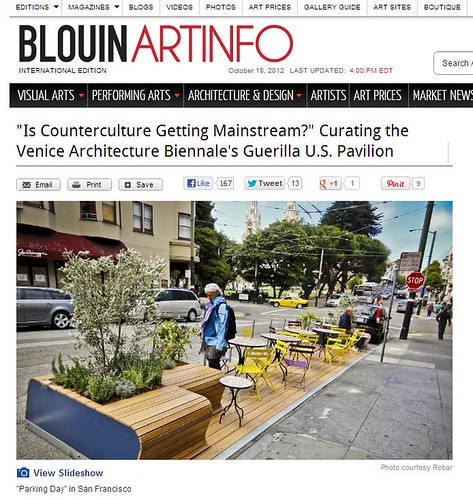The theme of the U.S. Pavilion at the Venice Architecture Biennale this year is “Spontaneous Interventions: Design Actions for the Common Good.†Cathy Lang Ho, who helped to select the participants, discusses the criteria and the approach in this article over at the Architect Magazine site. This is hardly the first post about spontaneous or “pop-up” urbanism. In fact, you can hardly get away from it if you read architecture or planning blogs.
We are constantly being told that we have to do more with less and civic improvements need to be quicker, faster and cheaper. The parklet movement has roots in both San Francisco and New York City, places with two of the world’s largest and most grand civic parks built with public funds for the benefits of their citizens. Many of the greatest public works projects in U.S. history, like the Hoover Dam and most of the U.S. National Parks System, were constructed during the great depression . Today Apple sits on a pile of money big enough to bail out a European economy while California cuts school bus service and reduces funding for public universities to levels unthinkable a few years ago.
How is the profession fighting back? Architects are responding to the outrageous prioritization of the wealthy over the many by donating their time to the “common good” via vanity projects that allow tech workers to set up their MacBooks on brand new privately-funded outdoor patios in San Francisco’s most gentrified neighborhoods. Great.
It’s not that there is inherently anything wrong with parklets or pop-up urbanism in a general sense. There are actually some benefits. Let’s not kid ourselves, however- this is NOT ‘Guerrilla Urbanism.’ Perhaps I don’t https://purchasepropecia.net know exactly what this term means, but I know it’s not what is depicted in the image above. The Critical Mass bicycle ride comes much closer to Guerrilla Urbanism than designing patio seating for a coffee shop, and even that is a stretch.
Another exhibit in the Biennale comes closer to the true spirit of working for the common good, that is the OMA-curated exhibit titled “Public Works: Architecture by Civil Servants.” Exhibiting the work done by mostly anonymous public employees around Europe in the 1970s, the show glorifies work that was done for the good of society by people who would never see their own names on the drawings. OMA shows what it means to actually prioritize the mass public of society via investment in the common good- rather than looking at government as a problem, the ‘other,’ or something that needs to be tamed, government is part of the solution for a better world.
Architects have very little power (less power than anyone involved except for the architecture critics themselves). It is hard to figure out how to respond to a society that has become increasingly weighted towards those at the top at the expense of the entire idea of ‘society.’  Doing things for your local community is a part of the solution. However, donating your services so a for-profit business can have more seating is not on par with helping Habitat for Humanity build houses for the truly needy or fighting to restore funding to your local school system. Pick your battles wisely and take note of whether you are actually making yourself part of the solution.
